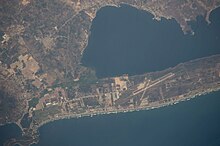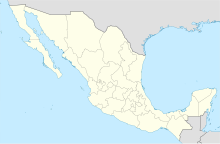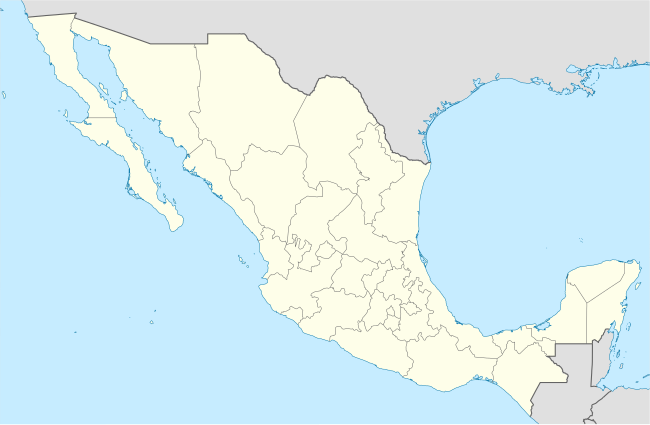Acapulco International Airport
Acapulco International Airport Aeropuerto Internacional de Acapulco | |||||||||||||||
|---|---|---|---|---|---|---|---|---|---|---|---|---|---|---|---|
 | |||||||||||||||
| Summary | |||||||||||||||
| Airport type | Public | ||||||||||||||
| Owner/Operator | Grupo Aeroportuario Centro Norte | ||||||||||||||
| Serves | Acapulco, Guerrero, Mexico | ||||||||||||||
| Time zone | CST (UTC-06:00) | ||||||||||||||
| Elevation AMSL | 4 m / 13 ft | ||||||||||||||
| Coordinates | 16°45′21.7″N 99°45′05.8″W / 16.756028°N 99.751611°W | ||||||||||||||
| Website | www | ||||||||||||||
| Map | |||||||||||||||
 | |||||||||||||||
| Runways | |||||||||||||||
| |||||||||||||||
| Statistics (2023) | |||||||||||||||
| |||||||||||||||
Source: Grupo Aeroportuario Centro Norte[1] | |||||||||||||||
Acapulco International Airport (Spanish: Aeropuerto Internacional de Acapulco), officially Aeropuerto Internacional General Juan N. Álvarez (General Juan N. Álvarez International Airport) (IATA: ACA, ICAO: MMAA), is an international airport located in Acapulco, Guerrero, Mexico. It serves as a gateway to Acapulco, a popular Mexican tourist destination. The airport also serves charter flights and facilitates various tourism-related activities, flight training, and general aviation. It is named in honor of Juan N. Álvarez, former President of Mexico. The airport is operated by Grupo Aeroportuario Centro Norte (OMA). In 2022, the airport handled 838,991 passengers, and in 2023 it handled 894,012 passengers.[1]
History
[edit]

In 1929, commercial flights began in Acapulco, near Playa Hornos in the city center. Aeronaves de Mexico (now Aeromexico) initiated its operations in 1934, using a single Stinson SR aircraft for flights between Mexico City and Acapulco.[2] However, the initial location posed safety challenges, leading to the construction of a safer airport in Pie de la Cuesta in 1945.
Jetset era
[edit]Acapulco Airport has played a significant role in the development of tourism in southern Mexico. Acapulco, a well-established coastal tourist destination in Mexico, experienced a period of high popularity from the 1940s to the 1970s. It became the preferred destination for the Jetset, Hollywood celebrities, and wealthy individuals seeking exclusive beach vacations in an exotic setting. During this surge in popularity, the decision was made to construct a new airport and transfer the Pie de la Cuesta facilities to the Mexican Air Force, now known as Air Force Base No. 7.[3]
The current Acapulco Airport, constructed in 1954, is situated 16 kilometres (9.9 mi) southeast of the city center, positioned between Tres Palos Lagoon and the Pacific Ocean in a zone known as Plan de los Amates. It was once considered a pioneering model for subsequent airport constructions due to its modern passenger terminal design and the fact that it was one of the first airports built with comprehensive planning and foresight.

The Acapulco Airport received flights from numerous international destinations, primarily from the United States and Canada. It was one of the few airports, apart from Mexico City, that was served by major United States airlines such as Eastern, Braniff, and American. For a brief period, it was a stopover on the Kangaroo air route connecting Australia and the United Kingdom via the Eastern Hemisphere. This route, known as the "Fiesta" route, involved flights from London to Sydney with layovers in Bermuda, Nassau, Mexico City, Acapulco, Tahiti, and Fiji in 1965.[4] Several other airlines, including Delta, Alaska Airlines, Air Canada, Alitalia, LTU, Northwest, US Airways, Western, Mexicana, and Aeromar, have also operated at this airport.
Between 1970 and 1973, the airport underwent significant construction and improvement projects, including the construction of a new, air-conditioned passenger terminal, a new parking area, an access road, a control tower, an apron, taxiways, perimeter roads, fencing, and facilities for fuel storage.
21st century
[edit]However, in the 21st century, the Mexican Drug War has had a detrimental effect on tourism in Acapulco, resulting in a decline in the airport's importance as an international gateway. The airport reached its peak in terms of passenger numbers in 2008 but has since been experiencing a decline. In 2018, the terminal was renovated, with the construction of a new terminal building adjacent to the old one, with plans to eventually demolish the old structure.[5][6]
Furthermore, the airport has been subjected to the impact of hurricanes on multiple occasions. In 2013, Tropical Storm Manuel led to severe flooding at the airport, which forced the suspension of airport activities for several days. In 2023, Hurricane Otis, classified as a Category 5 hurricane, caused extensive damage at the airport when it made landfall nearby.

Facilities
[edit]The airport covers an area of 450 hectares (1,100 acres). It is situated at an elevation of 4 metres (13 ft) above mean sea level. The airport has two runways: Runway 06/24, which is 1,700 metres (5,600 ft) long and 35 metres (115 ft) wide, and Runway 10/28, which is 3,300 metres (10,800 ft) long and 45 metres (148 ft) wide. Both runways can accommodate up to 40 operations per hour, and the airport can handle jets as large as the Boeing 747. Additionally, the airport has six taxiways leading to an apron with 18 parking positions.
The passenger terminal is a two-story building with a total floor area of 19,000 square metres (200,000 sq ft) and an annual passenger capacity of 1.3 million. It combines concrete and steel structures with extensive interior and exterior gardens, sleek windows, high ceilings, and steel accents in clear geometric shapes.[7][8]

The main hall serves essential functions, including check-in and baggage handling on the eastern side, and the arrivals section on the west side, which includes customs and immigration facilities. The arrivals section also offers car rental services, taxi stands, snack bars, and souvenir shops. The upper floor of the terminal houses the security checkpoint and a 3,600 square metres (39,000 sq ft) departure lounge equipped with a food court, duty-free shops, a VIP lounge, and a concourse with six gates, three of which are equipped with jet bridges.[9]
Adjacent to the terminal, there are other facilities such as civil aviation hangars, cargo and logistics companies, and courier services. Additionally, there is a dedicated general aviation terminal that supports various activities, including tourism, flight training, executive aviation, and general aviation.
Airlines and destinations
[edit]Passenger
[edit]| Airlines | Destinations |
|---|---|
| Aeroméxico | Mexico City |
| Aeroméxico Connect | Mexico City |
| Air Transat | Seasonal: Montréal–Trudeau |
| American Eagle | Seasonal: Dallas/Fort Worth |
| Magni | Monterrey |
| Sunwing Airlines | Seasonal: Montréal–Trudeau, Toronto–Pearson |
| United Express | Seasonal: Houston–Intercontinental |
| Viva | Mexico City–AIFA, Monterrey[10] |
| Volaris | Guadalajara, Mexico City, Tijuana |
Destination maps
[edit]Domestic destinations from Acapulco International Airport Red = Year-round destination Blue = Future destination Green = Seasonal destination |
International destinations from Acapulco International Airport Red = Year-round destination Blue = Future destination Green = Seasonal destination |
Statistics
[edit]
Passengers
[edit]Graphs are unavailable due to technical issues. Updates on reimplementing the Graph extension, which will be known as the Chart extension, can be found on Phabricator and on MediaWiki.org. |
Annual traffic
[edit]



| Year | Passengers | % change | Domestic passengers |
% change | International passengers |
% change |
|---|---|---|---|---|---|---|
| 2001 | 940 197 | 569 195 | 371 002 | |||
| 2002 | 793 420 | 523 172 | 270 248 | |||
| 2003 | 774 349 | 527 208 | 247 141 | |||
| 2004 | 821 301 | 542 437 | 278 864 | |||
| 2005 | 880 190 | 554 988 | 325 202 | |||
| 2006 | 994 393 | 638 543 | 355 850 | |||
| 2007 | 1 057 332 | 740 289 | 317 043 | |||
| 2008 | 1 087 974 | 818 671 | 269 303 | |||
| 2009 | 839 048 | 636 418 | 202 630 | |||
| 2010 | 736 878 | 547 420 | 189 458 | |||
| 2011 | 596 326 | 495 018 | 101 308 | |||
| 2012 | 546 951 | 486 268 | 60 683 | |||
| 2013 | 617 079 | 560 945 | 56 134 | |||
| 2014 | 631 570 | 576 042 | 55 528 | |||
| 2015 | 730 382 | 677 698 | 52 684 | |||
| 2016 | 718 493 | 664 418 | 54 075 | |||
| 2017 | 673 809 | 631 829 | 53 295 | |||
| 2018 | 739 120 | 681 587 | 57 533 | |||
| 2019 | 875 315 | 814 636 | 60 679 | |||
| 2020 | 395 948 | 361 029 | 34 919 | |||
| 2021 | 670 239 | 623 763 | 46 476 | |||
| 2022 | 838 991 | 773 846 | 65 145 | |||
| 2023 | 894 012 | 838 123 | 55 889 |
Busiest routes
[edit]
| Rank | City | Passengers | Ranking | Airline |
|---|---|---|---|---|
| 1 | 230,260 | Aeroméxico, Aeroméxico Connect, Volaris, Viva Aerobus | ||
| 2 | 74,300 | Volaris | ||
| 3 | 43,154 | Volaris | ||
| 4 | 32,345 | Aeroméxico Connect, Viva Aerobus, Volaris | ||
| 5 | 20,460 | Magni, Viva Aerobus | ||
| 6 | 13,579 | Viva Aerobus | ||
| 7 | 4,955 | Air Transat, Sunwing Airlines | ||
| 8 | 4,955 | United Express | ||
| 9 | 3,128 | Volaris | ||
| 10 | 2,752 | American Eagle |
See also
[edit]
- List of the busiest airports in Mexico
- List of airports in Mexico
- List of airports by ICAO code: M
- List of busiest airports in North America
- List of the busiest airports in Latin America
- Transportation in Mexico
- Tourism in Mexico
- Grupo Aeroportuario Centro Norte
- List of beaches in Mexico
- Triangle of the Sun
- Kangaroo Route
References
[edit]

- ^ a b "OMA's December 2023 Total Passenger Traffic" (PDF). oma.aero. Grupo Aeroportuario del Centro Norte S.A.B. de C.V. 8 January 2024. Retrieved 27 January 2024.
- ^ "Stinson Reliant SR-5A, joya aeronáutica" (in Spanish).
- ^ "AEROPUERTOS. Historia de la construcción, operación y administración aeroportuaria en México" (PDF) (in Spanish).
- ^ "From Twelve Days To Non-Stop In 20 Hours".
- ^ "OMA invertirá 547 mdp en nueva terminal de Aeropuerto de Acapulco • Forbes México". Forbes México (in Mexican Spanish). 13 June 2016. Retrieved 3 October 2020.
- ^ "¡La nueva terminal del Aeropuerto de #Acapulco, a la altura de la belleza incomparable del puerto!". Mexican Government (in Spanish). 25 May 2018. Retrieved 3 October 2020.
- ^ "OMA opens new terminal in Mexico".
- ^ "Acapulco Airport Opens New Terminal". Travel Agent Central. 30 May 2018. Retrieved 3 October 2020.
- ^ "Acapulco Adding New Terminal to Airport".
- ^ "Acapulco recovers air connectivity with flights from Monterrey". ANEWS (in Spanish). May 2024. Retrieved 11 June 2024.
- ^ "Investor Relations". Grupo Aeroportuario Centro Norte de México. January 2017. Retrieved 16 January 2017.
- ^ a b "Passenger's Traffic". Grupo Aeroportuario Centro Norte de México. January 2017. Archived from the original (XLS) on 22 December 2015. Retrieved 16 January 2017.
- ^ "Estadística operacional por origen-destino / Traffic Statistics by City Pairs" (in Spanish). Agencia Federal de Aviación Civil. January 2024. Retrieved 1 February 2024.
External links
[edit]
 Media related to Juan N. Álvarez International Airport, Acapulco at Wikimedia Commons
Media related to Juan N. Álvarez International Airport, Acapulco at Wikimedia Commons- Official Website
- Grupo Aeroportuario Centro Norte
- Aeronautical chart and airport information for MMAA at SkyVector
- Current weather for MMAA at NOAA/NWS
- Acapulco Airport information at Great Circle Mapper
- Accident history for ACA at Aviation Safety Network
- Tourism in Acapulco




